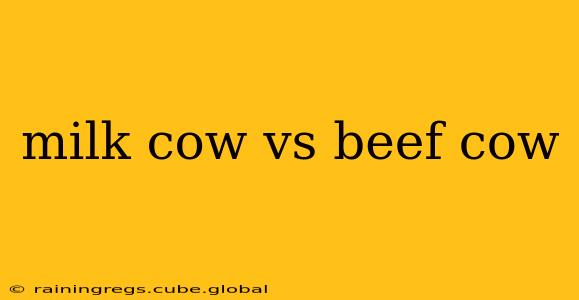Choosing between a milk cow and a beef cow depends entirely on your goals. Are you looking for a dairy product source, or are you focused on raising animals for meat? Understanding the key differences between these two types of cattle is crucial for making an informed decision. This comprehensive guide will explore the distinctions in breed characteristics, physical attributes, temperament, and economic considerations.
What are the Key Differences Between Milk Cows and Beef Cows?
The most fundamental difference lies in their primary purpose: milk production versus meat production. This distinction influences nearly every aspect of their breeding, raising, and overall characteristics.
-
Breed: Dairy breeds are selectively bred for high milk yield, while beef breeds are selected for efficient muscle growth and carcass quality. You'll find drastically different breeds specializing in each category. Examples of dairy breeds include Holstein Friesian, Jersey, and Guernsey, while Angus, Hereford, and Charolais are popular beef breeds.
-
Physical Appearance: Dairy cows are typically leaner and more angular than beef cows. Their bodies are designed for efficient energy conversion into milk production, not muscle mass. Beef cows are generally larger, heavier, and more muscular, with a broader build suited for meat production.
-
Milk Production: This is the most obvious distinction. Dairy cows produce large quantities of milk throughout their lactation period, while beef cows produce very little milk, primarily for nourishing their calves.
-
Temperament: While individual temperaments can vary within breeds, dairy cows are often described as more docile and easier to handle, especially those bred for dairy farming. Beef cattle can be more independent and potentially more challenging to manage.
What is the Difference in the Amount of Milk Produced?
Dairy cows are incredibly efficient milk-producing machines. A high-producing Holstein cow can yield over 25,000 kilograms (around 55,000 pounds) of milk annually. This significantly contrasts with beef cows, which produce minimal amounts of milk, typically only sufficient for nourishing their calves. The milk yield of a beef cow is far too low to be commercially viable for dairy purposes.
What is the Purpose of Raising a Beef Cow?
The primary purpose of raising a beef cow is to produce meat. Beef cattle are raised for their high-quality meat, valued for its flavor, tenderness, and nutritional content. Farmers select breeds known for their efficient muscle growth, desirable carcass characteristics (e.g., marbling), and ability to thrive in specific environments.
How Much Milk Does a Beef Cow Produce?
As mentioned earlier, a beef cow produces a negligible amount of milk compared to a dairy cow. The milk produced is primarily for the calf's nourishment and is not suitable for commercial dairy operations. The quantity might range from a few liters per day for a short period after calving to almost none after weaning.
What are the Different Breeds of Milk and Beef Cows?
There's a wide diversity of breeds within both categories. Some popular dairy breeds include:
- Holstein Friesian: Known for high milk volume.
- Jersey: Produces rich, high-butterfat milk.
- Guernsey: Similar to Jersey in milk quality.
Popular beef breeds include:
- Angus: Known for excellent marbling and meat quality.
- Hereford: Hardy and adaptable breed.
- Charolais: Large, fast-growing breed.
Are There Any Crossbreeds?
Yes, crossbreeding is common in both dairy and beef cattle farming. Crossbreeding can combine desirable traits from different breeds, such as improved milk yield, disease resistance, or meat quality. This allows farmers to optimize their herds for specific needs and environmental conditions.
This detailed comparison clarifies the significant differences between milk cows and beef cows, highlighting their distinct purposes, physical characteristics, and economic implications. The choice between them depends entirely on the specific goals and resources of the farmer or rancher.
